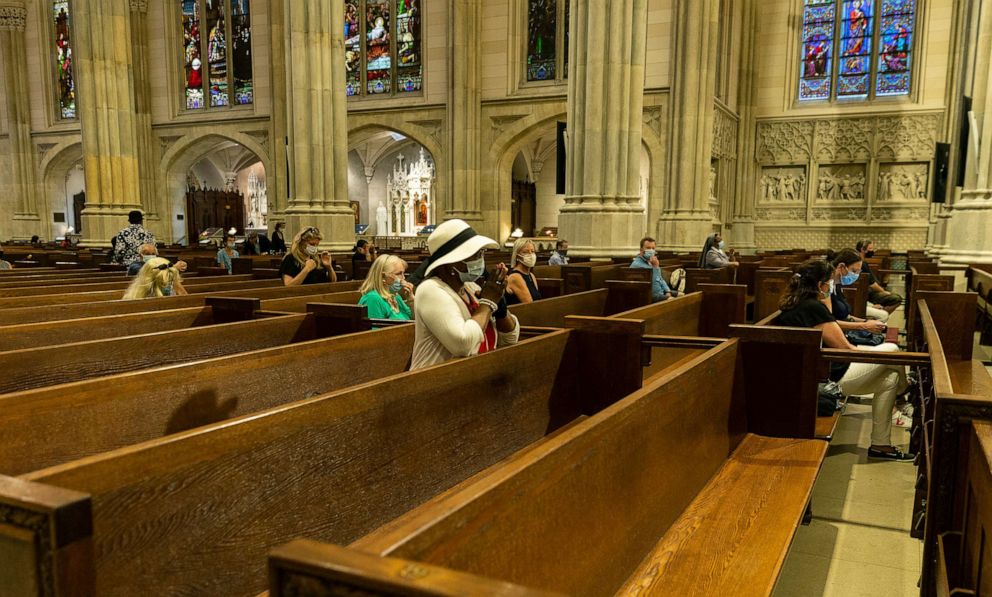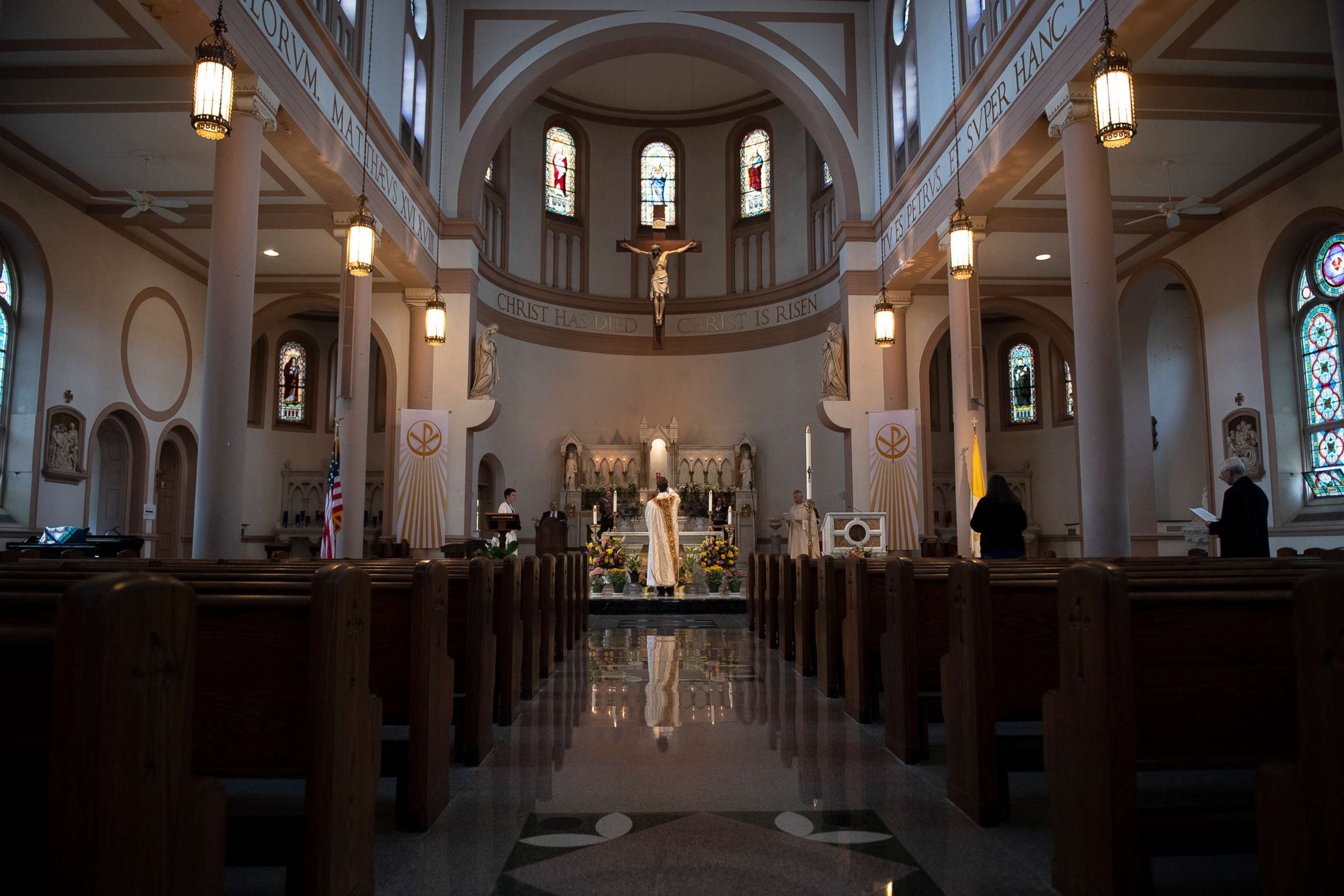COVID-19 pandemic forces a nationwide reckoning for American churches on how to safely reopen
Church attendance dropped during the pandemic.
Since the start of the pandemic, in-person church attendance dropped a staggering 45% nationwide, according to an ABC analysis of churches across more than 3,000 U.S. counties from cellular phone data provided by Safegraph.
For the past two years, many congregations have turned to virtual services to stay connected.
"The phenomenon of 'pancake church' thrived during the pandemic -- eat pancakes and watch church on TV," said Dr. Brent Taylor, senior pastor at First Baptist Church at The Fields in Carrollton, Texas.
But church leaders suggest that for most, all-virtual services are not sustainable in the long term, because the current situation is draining churches financially and dampening the experience for many. Church leaders tell ABC News people are more likely to donate when at in-person services. Also, the morale of the community is negatively impacted without the human interaction that comes with people physically attending services, they say.

Recently, many churches are starting to bounce back with a hybrid model -- a mix of in-person and virtual worship -- with some faith leaders seeing congregation numbers growing once again and new parishioners come to their churches.
"Attendance was smaller at the beginning and these numbers have risen to where we currently are to pre-pandemic level but we are still also offering virtual services," Taylor added.
Faith leaders must grapple with the risks of in-person worship, while also reckoning with the politicization of vaccinates and mask mandates. Many are still struggling, their challenges unique depending on the demographics of their local communities.
"We don't have a playbook here, we don't have a precedent," said Dr. Terence Rhone, national director of pulmonology for the Care More Health Plan and pastor of Mt. Sinai Church of God in Christ near Los Angeles.
Furthermore, the data showed there were differences in attendance within the counties with different predominant religious affiliations. Ten small Southern counties -- and the nation's only predominantly Black Protestant counties -- lost 62% of its in-person worshipers during the nearly two-year period. That was the largest attendance loss among counties with a majority of worshippers of a particular religious affiliation.
But at the same time, attendance dropped only 43% in Southern counties where residents were predominantly Evangelical Protestant. These patterns suggest that in addition to regional, cultural and accessibility biases, differences in church doctrine about faith and medicine or church attendance policies may have also been a factor in sanctuary worship during the pandemic.
While some churches are now experiencing more of their parishioners returning to the pews, others have had no choice but to close their doors permanently.
"Pastors are feeling the impact of this pandemic and they're just being driven to a point of exhaustion, both mentally and emotionally," said Rhone.
The lack of or limit in attendance cuts much needed revenue to keep churches open, especially those with few members. Add to that the constant debates on which practical and affordable health safety protocols to implement, recurrent case surges and updates to health recommendations creates a crucible of challenges for churches.
"I am seeing pastors quitting ministry because they are exhausted and tired of political fights," said Taylor.
For those seeking to return to in-person services, new variant-fueled surges are compelling religious leaders to evaluate how to gather safely. Some worship leaders have implemented mandate masks, social distancing and limits on the number of people who can attend in-person. Others have their choir members get tested prior to singing their hymns on Sunday morning and others are installing systems to improve ventilation in their sanctuaries.

These new approaches to attend church in person are being welcomed by some members.
"The COVID mitigation some churches have put in place have made parishioners comfortable," said churchgoer Latasha Barnes, describing her experience returning to in-person worship. She chose to return to in-person rather than attend virtually, because she wanted to feel more engaged.
"When you first come in you have a mask ready, everyone gets their temperature checked and hand sanitizers throughout the church. We even seat by family to minimize risk and ushers make sure traffic is minimized," Barnes added.
But church leaders and churchgoers say the return to in-person service can also take an emotional toll, because many members of the congregation have passed away from COVID-19.
"Church is a reminder of people that have died because you don't see them next to you in the pew," said Dr. Green, CEO of Family Christian Health Center in Harvey, Illinois.
And church leaders say that due to the ongoing threat, many churches will continue to offer virtual services for their members. The option of worshiping while being in the comforts of one's own home and remaining safe has been a welcomed alternative for many. This option is becoming more and more popular to the point that some leaders find it as a necessary tool for engagement, especially during the pandemic.
"The future of the church is a hybrid model, I believe, because you're just going to see more and more people that are following you online, instead of coming to your sanctuary," said Rhone
Congregation leaders agreed there is a long way to go to determine a "new normal" of worship. Every house of worship will have its specific factors and risks to assess which decisions are the safest. It will take time, but many leaders are still hopeful that public health and science guide decisions that will be made.
Alexis E. Carrington, M.D. is an associate producer at ABC News' Medical Unit and a rising dermatology resident at George Washington University. Mark Nichols is senior manager of data journalism for ABC News. Dr. Jay Bhatt is an internist, instructor at UIC School of Public Health and an ABC News contributor.




